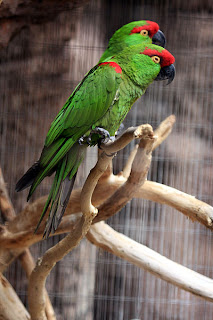Thick-billed Parrot
The Thick-billed Parrot, Rhynchopsitta pachyrhyncha is an endangered, medium-sized, up to 38 cm long, bright green parrot with a large black bill and a red forecrown, shoulder and thighs. It is found in Mexico, and its former range extended marginally into the United States.
 |
| Thick-billed Parrot |
image source: http://www.flickr.com/photos/59323989@N00
 |
| Thick-billed Parrot |
image source: http://www.flickr.com/photos/7326810@N08/
Description
The Thick-billed Parrot is a medium-sized, up to 38 cm (15 in) long, bright green parrot with a large black bill and a red forecrown, shoulder and thighs. Adult eyes are amber, while juveniles have brown eyes. The rest of the bird is bright green. Thick-billed Parrots show red shoulders and leading edge on the underwing, followed by a blackish green stripe, then a yellow stripe, followed by the remaining underwing showing dark green. It appears to show a blackish tail.
Distribution and habitat
The Thick-billed Parrot lives in temperate conifer, pine, mature pine-oak and fir forests from 1200 to 3600 meters. For the most part, it is restricted to the Sierra Madre Occidental of Mexico, though it was formerly a rare visitor to the southwestern United States.
Behavior
The Thick-billed Parrot likes to nest in tree cavities, especially old woodpecker holes. It mainly feeds on seeds from various pine species, so much so their entire lives revolve around cone production. Flocks of these parrots roost by cliffs and they breed at the peak of pine seed production. It is nomadic, following the variations of cone abundance. The bird sounds like a high pitched macaw and makes a variety of harsh, rolling calls. They are adept fliers.
Status
Habitat destruction and illegal bird trading gives the Thick-billed Parrot its endangered status on the IUCN Red List of Threatened Species and listing on Appendix I of CITES. It is estimated that only 1000-4000 Thick-billed Parrots exist. However, this last living parrot species native to the United States is well-established in captive breeding programs in many zoos across the world. Birds had been reintroduced in Arizona in the early 1980s, but this effort turned out to be unsuccessful. The parrots could not adapt to avoiding natural predators.